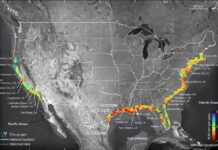By Amanda Ojeda
On October 29, a public announcement was made by the United States Fish and Wildlife Service (USFWS) that stated, gray wolves (Canis lupus) would be delisted from the Endangered Species Act (ESA), in most of the contiguous 48 states. A few days later on November 3rd, it was officially published in the Federal Register. The terms to this delisting will take full effect January 4, 2021.
The grey wolves were initially added onto the ESA list more than 45 years ago. This was due to constant poisoning and shootings by farmers who viewed them as pests. They were also often hunted as trophies, and for the use of their pelts. The killings worsened in the 70’s and the species were added to the list when the population dropped to 1,000 in the contiguous 48 states. Currently grey wolf populations are at about 6,000 in the lower 48, and 7,000-11,000 in Alaska (never under ESA protection), and 300,000 worldwide. The jump from 1,000 to 6,000 is remarkable progress, however, some scientists say that the recovery of grey wolves is still in a premature state.
“The Trump administration plan, if not stopped in the courts, would result in at least 1,500 wolves being killed a year in the three Great Lakes states, with the states seeking to use steel-jawed leghold traps and snares,” said Wayne Pacelle, the President of Animal Wellness Action.
So, what does this delisting mean, one may ask. It means that gray wolves have lost protection rights under a national level. Under the ESA it was illegal in the contiguous 48 states to kill a gray wolf. It is now up to state laws, legislations, and organizations to protect the species. Grateful for the change, many farmers are glad to be able to protect their land and livestock from such predators. However, a group of environmentalists and wolf advocates have been planning a potential lawsuit if a compromise for partial protection is not met within the 60 days before the new rule will take effect.
Tom Wheeler, the executive director of the Environmental Protection Information Center, claims that there has been progress for the species, but at different paces depending on the region. The choice to remove gray wolves from the list, made by the Trump Administration, was also so close to the election that many wondered whether it was a political move. Many people, like Wheeler, believe that it was politicized, continuing by saying, “In states where wolf recovery has become more realized, wolf listing is controversial. It appears that the Trump administration is trying to lean into that controversy and exploit it for political ends.”
Though the timing was quite iffy, the decision to delist wasn’t necessarily completely out of the blue. The Obama Administration back in 2013 also attempted to delist these wolves from the ESA, believing that the grey wolves recovered enough. Until that potential delisting was invalidated in 2014.
United States Fish and Wildlife Service (USFWS) spokesperson Vanessa Kauffman on the delisting, mentions that the decision was, “based on the parameters of the law and the best scientific and commercial data available.”
Also, at the Minnesota Valley National Wildlife Refuge, Interior Secretary David Bernhardt states, “After more than 45 years as a listed species, the gray wolf has exceeded all conservation goals for recovery. Today’s announcement simply reflects the determination that this species is neither a threatened nor endangered species based on the specific factors Congress has laid out in the law.”
Though both statements made by Kauffman and Bernhardt were directed to assure the public that this decision was supported and safe for the species, many are wary of what the future may hold for grey wolves.










